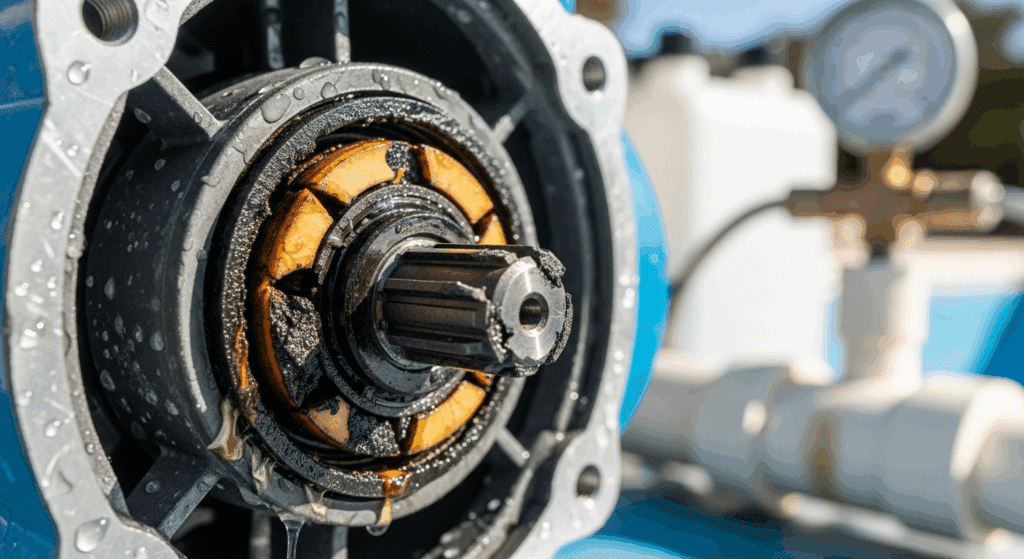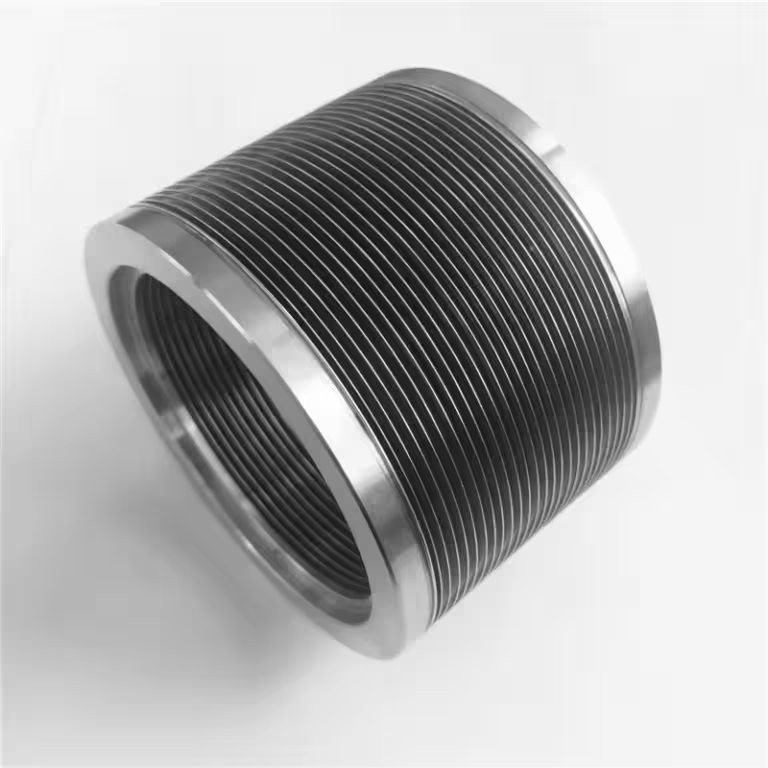Your pool pump’s mechanical seal is like the heart of your circulation system. It relies on water flowing through it constantly for both cooling and lubrication. Stop that water, and the seal will fail in minutes.
When a pump runs without adequate water—called “dry running”—the friction between internal components skyrockets. The seal overheats and cracks almost instantly. What starts as a $300-400 repair (seal replacement) can turn into a $1,200-2,500 pump replacement if you don’t catch it fast.

Immediate Warning Signs (Listen & Watch)
You don’t need special tools to spot dry running. Your ears and eyes tell the story.
Unusual Noises
A pump running dry sounds angry. You’ll hear grinding, screeching, or squealing—not the normal quiet hum you’re used to.
These noises come from excessive friction as the seal deteriorates. The grinding “roar” of damaged bearings is especially distinctive and unmistakable. If you hear sudden weird sounds, shut the pump off immediately.
Burning Smell
The combination of an overheating motor and scorched pump seal creates a sharp, acrid smell. It smells like burning plastic or electrical insulation.
If you catch a whiff of this near your pump, dry running is almost certainly happening. The smell is strong enough that you’ll notice it even from several feet away.
Overheating
Feel the pump housing. A normal pump is warm to the touch. A pump running dry becomes extremely hot—hot enough to burn your hand if you’re not careful.
A pump can reach internal temperatures of 300-400°F within minutes without water to cool it down. If the pump is too hot to hold your hand on, stop running it immediately.
Sudden Loss of Water Flow or Pressure
Check your filter pressure gauge and return jets. Are they weaker than normal?
A pump that has run dry loses its prime or develops severely diminished flow. You’ll see low filter pressure, reduced water circulation, and possibly air bubbles in the pump basket or returns.
Physical Evidence of a Dry-Run Seal
After suspected dry running, these visible signs confirm the pump took damage.
Water Leaking From the Seal Plate
The seal plate is where the motor bolts to the pump housing. Look underneath—this is where a failed shaft seal always leaks.
Water trickles down the back of the seal plate and drips off the bottom. The leak point is distinctive: water coming from the underside center of the pump where the shaft connects (not from loose pipe fittings above).
Even a slow drip signals seal failure. If you see moisture there, replacement is needed.
Melted or Warped Plastic Components
Extreme heat warps plastic parts. Look at the pump basket, volute (housing), and PVC fittings attached to the pump.
Do they appear shrunken, distorted, blistered, or discolored? These are telltale signs the pump experienced severe overheating. Heat-damaged fittings often develop new air or water leaks, worsening the problem.
White Residue or Discoloration on Seal Faces
The mechanical seal has a polished ceramic face mated against a carbon face. When it overheats from dry running, the seal face turns white.
You’ll only see this if you disassemble the pump, but pool technicians use it as a diagnostic clue. Water that leaked into the motor leaves white calcium deposits and rust around the motor’s front end—dried mineral deposits from escaped water.
Seized or Stiff Pump Shaft
With the power off and after the pump cools, try gently rotating the motor shaft or impeller by hand.
A pump that ran dry may have a seized shaft or much more friction than normal. If the shaft won’t turn at all, the pump likely suffered significant internal damage from melted seal parts or heat-damaged bearings.
How to Diagnose a Dry-Run Problem
Don’t guess—follow these diagnostic steps to confirm what happened.
1. Shut Off the Pump Immediately
Never continue running a pump you suspect ran dry. Turn off the power right away.
Allow the system to cool for at least 20-30 minutes before touching anything. A pump can be hot enough to cause burns.
2. Check the Strainer Basket Water Level
Look through the pump’s strainer lid. Is the basket empty or only partially filled with water?
A pump that lost its prime (little to no water in the pot) definitely ran dry. While you’re there, inspect for clogs. A basket packed with debris can starve the pump of water and cause dry running.
Remove any debris and ensure incoming lines are clear before restarting the pump.
3. Inspect Water Level and Valves
Verify the pool water level is at least at the midpoint of the skimmer. If water level was low, that explains the dry-run condition.
Also confirm all suction line valves were open. Check that nothing blocked the flow—like a skimmer weir stuck in the closed position. These simple oversights cause most dry running incidents.
4. Look for Leaks at the Seal Plate
With the pump off, use a flashlight to examine the joint between the motor and pump housing (seal plate area).
Any water dripping from this interface or wetness underneath the pump points to a failed shaft seal. If water is leaking even when the pump is off, the seal is definitely compromised.
Dry the area and observe carefully when the pump runs to ensure the water isn’t coming from a loose pipe fitting above.
5. Feel the Pump Housing Temperature
Carefully tap the pump housing and motor exterior. Does it still feel extremely hot long after shutdown?
Extreme residual heat indicates the pump overheated from dry running. Use an infrared thermometer to document the temperature if needed.
6. Listen on Restart (If Safe)
Once water supply is restored and the pump is reprimed, you might do a brief test run. Listen for grinding or screeching sounds.
Loud bearing noise could mean water penetrated the motor. Screeching could mean the new seal surfaces are damaged. Watch the pump’s pressure and flow—if it’s not pumping properly (low flow or pressure), the pump might still be air-bound or the impeller may be damaged.
If severe noises or lack of flow persist, shut it off again immediately.
7. Check the Timeline
How long did the pump run dry? The timeline tells you how serious the damage is.
30 seconds to 1 minute: Seal faces can crack or burn up. Water starts leaking at the bottom of the pump.
15 minutes to 1 hour: Plastic components like the pump basket may warp or soften. Motor windings begin overheating.
1-4 hours: Impeller warping, more severe seal damage, and motor insulation breakdown.
6+ hours: Catastrophic damage—melted plastic parts, seized bearings, potential motor burnout.
Why This Happened: Common Causes
Low Pool Water Level
This is the #1 cause of dry running. When pool water drops below the skimmer midpoint, the pump sucks in air along with water.
Evaporation, heavy splashing, or simply forgetting to refill the pool during hot weather can drop your water level fast. Check the water level regularly, especially during summer.
Clogged Skimmer or Pump Baskets
Leaves, hair, bugs, and debris accumulate in your skimmer and pump baskets. A clogged basket chokes off water supply to the pump.
The pump can’t pull enough water, loses prime, and runs dry. This happens gradually, so many pool owners don’t realize their baskets need cleaning until damage occurs.
Air Leaks in Suction Lines
Even if your pool water level is fine, air leaks on the suction side of your plumbing can break the prime and cause dry running.
Common culprits include a worn pump lid O-ring, loose pump drain plugs, or cracked PVC fittings. If you notice air bubbles in the pump basket, you have an air leak somewhere.
Closed Valves or Blocked Lines
Did someone accidentally close a valve? Is a line kinked or blocked?
These simple oversights starve the pump of water and cause it to run dry. Check all suction line valves before assuming your pump has a problem.
Conclusion
Your pool pump is the heart of your entire circulation system. Recognizing the early signs of dry running—unusual noises, burning smells, overheating, and loss of flow—gives you the chance to act before catastrophic damage occurs.
The difference between a quick $300-400 seal replacement and a $2,500 motor replacement often comes down to minutes. If you catch dry running early, shut the pump off immediately, diagnose what caused it, and fix the problem.




